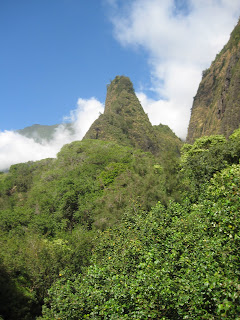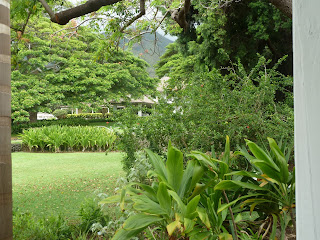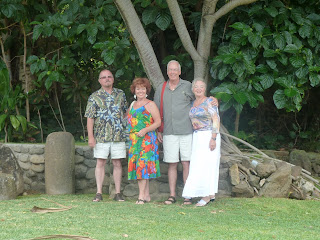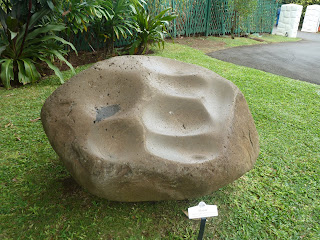Judi and Kevin Ritcey and their friends Molly and Joe were recent guests at our
Maui Garden House. Today's blog is an excerpt from one of Judi's daily Maui journals. Many Mahalos to Judi.
"We got as far as Wailuku and the Bailey House Museum. Now this is a little gem of a place to visit – if you like local history. We were there for about 1.5 hrs. and we learned so much and had a great time with the staff. They said they were sorry to see us leave. The house is located at the mouth of the Iao Valley. This is the burial place of the bones of the great Navigators and the kings and highest chiefs of Maui and other islands. Back in the 1795 the chiefs were very quick to see the value of western learning and therefore the missionaries sent by the ABCFM (American Board of Commissioners for Foreign Missions, based in Boston) were very welcomed by the Hawaiian people and the chief of Wailuku made some of the best lands available to them.

Males were educated in Lahaina and the Hawaiians wanted their girls educated as well. In 1837 the missionaries opened the Wailuku Female Seminary to educate girls to be good Christian wives. The first three teachers were Rev. Jonathan Green, his wife Theodosia, and Miss Maria Ogden [ who arrived completed with her spinning wheel]. They were followed by Edward Bailey and his wife Caroline and Bailey House was built. The school survived for 12 years after which time it was closed down due to lack of financing.
The Bailey Family story was wonderful to learn about and the house is full of artifacts of the house. Be sure to visit this site if you are ever on Maui.
The grounds were also very beautiful and well kept. I especially loved the Whale Blubber Kettle which was made into part of the garden landscape. The kettle was usually attached to the hull of a whaling vessel and was used to boil the whale blubber. This thing was huge. You’d think it would sink the ship.
The left side is flat so that it can be attached to the boat.
We learned a lot about the Poohala Tree. The bark of the tree Lao is used for making mats, sails and window coverings. The Ki which is a pod that falls off the tree is used by the native Hawaiians as a paint brush. What a great spot, under the Poohala tree for a group shot.
Just over from the tree there was a “Hoana” which is an ancient Adze grinding stone.
This was really cool. I couldn’t figure out how it would work, but it was a beautiful shaped stone. Look at the shape of it, isn’t that neat.
Also displayed on this site is one of the last KOA fishing canoes. It weighs 600 lbs. It is made of one solid KOA log. It is 33 feet long and 4 ¾ “wide. It is a Calabash shape [hour glass] which is very unique and it shows the original Adze marks on the hull.
Here is a picture of the canoe taken from a distance. It will show you how big it really was. 33 feet is a big canoe. Wouldn’t want to be on a trip and have to portage this sucker. It was great reading the history of the canoe and how it was actually made, and how the art of finding the right KOA tree was done by a select group of highly esteemed Hawaiians. It was no easy task.
We really did enjoy this unexpected historic site. We were able to pick up a book entitled “A Condensed History of the Hawaiian Islands” by Dr. Phil Barnes.
We were told by the museum ladies was the best book to learn about the Islands and to earn a respect for this wonderful people. I look forward to this read for sure.
We did the full museum tour, and learned lots more about this great family. The guide there was telling me that there is a great, great nephew of Edward Bailey who still lives in the area and who is a dead ringer for Edward. It’s kind of weird to see him walk into the house.
We also saw a display of feathered leis that were worn by the chieftains of the early 1800s. There was a tiny bird in one of the show cases with brilliant yellow feathers on the under belly. I felt so bad seeing this dead bird in the case, but wanted to know why it would be included in the display. The story was really interesting. The bird is called a “ö ö” bird. There were hunters who during molting season would capture these tiny birds, pluck out their yellow under feathers and then set the birds free to grow more. These feathers were used in chieftain leis and cloaks. The yellow colour was so rich looking – beautiful.
Just a few more photos of the garden residents and the lovely garden bench at the front of the house. The roosters were crowing all the time. It was so funny to hear them."
Making your base in a privately owned
Maui Vacation Rental is a must if you want to experience a comfortable and affordable Maui vacation while you explore this beautiful "Valley Isle"
 Christmas magic was in the air on Thursday evening at the Shops in Wailea on Maui.
Christmas magic was in the air on Thursday evening at the Shops in Wailea on Maui.















































